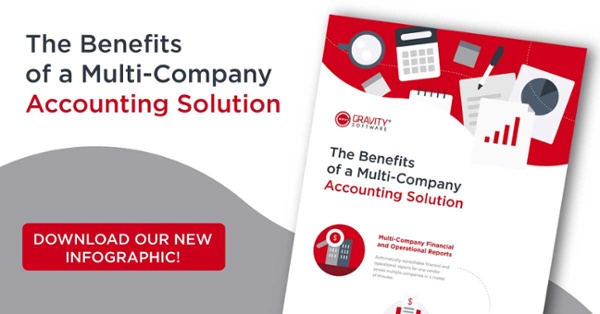7 signs you need multi-entity accounting software for growth

As your business grows and expands to include multiple subsidiaries or entities, managing financial operations can become increasingly complex. The accounting systems that once worked for a single entity often fail to support the needs of businesses with multiple legal entities. This creates inefficiencies, leads to manual processes, and can hinder your ability to scale. Recognizing the signs that you've outgrown your current system is key to implementing an accounting solution that helps drive growth. Here’s how to identify when it’s time to upgrade to multi-entity accounting software and optimize your financial processes.
1. End-of-month inter-company balancing is time-consuming
If your accounting team spends too much time balancing the inter-company accounts (such as “due to” and “due from”) every month, it’s a strong indicator that your current system isn't cutting it. Managing multiple vendors, entering duplicate data, and juggling separate databases for each subsidiary wastes time and increases the likelihood of errors.
A multi-entity accounting software solution, like Gravity Software’s multi-entity accounting, will automate these manual processes, freeing up your team to focus on more valuable tasks like generating insights and driving better financial decision-making for your company.
To learn more about how to manage intercompany transactions effectively, check out our detailed blog on Intercompany Transactions.
2. Consolidating reports and financial statements takes too long
Financial reports and statements are essential for leadership to assess your company’s health, but relying on spreadsheets and manual consolidation is inefficient. If your accounting staff spends hours compiling data and generating reports, it might be time to upgrade to a more advanced solution.
With multi-entity accounting software, you can automatically generate consolidated reports across all subsidiaries, improving accuracy and efficiency. Gravity Software’s Consolidated Financial Reporting feature allows you to quickly generate detailed financial statements, giving leadership the insights they need to drive smarter decisions and streamline financial management.
3. Allocating costs across multiple entities is complex
Allocating shared expenses across different entities should be simple and streamlined, but many systems require manual data entry and multiple transactions. If your accounting team is handling complex cost allocations for various subsidiaries, it’s time to consider upgrading.
Advanced multi-entity accounting software allows you to allocate expenses across entities in one transaction. This not only reduces the chance for errors but ensures the due-to and due-from accounts are automatically balanced, making your financial process more efficient and accurate.
4. Handle multi-currency accounting is challenging
If you operate in multiple countries with subsidiaries using different currencies, you’re likely facing challenges with foreign currency conversion and reconciliation. Basic accounting software may offer multi-currency functionality, but it lacks the depth needed for accurate and efficient multi-entity accounting.
With the right software, like Gravity Software’s Multi-Currency Solution, you can automate currency conversions and reconcile accounts across global subsidiaries. This ensures that all financial data is accurate and up-to-date, helping you manage your business more effectively across different regions.
“Gravity’s multi-entity accounting software also gives us the flexibility to keep track of expenses even for projects that are still in the research phase. Once they become approved projects, it’s easy to reallocate expenses to them using dimensions. The ability to manage multi-currency accounting has made a huge difference in ensuring accuracy and compliance.”
– Sofia Lambros, Head of Accounting, Proteus Power
For more details on how Gravity Software helps manage multi-currency accounting, check out the full Proteus Power case study.
5. Manual processes are costing time and money
When your company expands, it’s a sign that your business is thriving. But, if your existing accounting software requires manual processes, workarounds, and increases the workload for your accounting team, it's holding you back from reaching your full potential.
Investing in multi-entity accounting software will save you time and money by automating routine tasks like intercompany reconciliation, financial consolidations, and report generation. Your team can spend more time on strategic work that drives growth.
6. You need real-time financial data for smarter decisions
Managing multiple entities means you need up-to-the-minute financial data to make informed decisions. If your current system isn’t providing real-time access to your financials, your leadership team may be working with outdated or incomplete information—leading to suboptimal decisions.
With multi-entity accounting software, you’ll have real-time access to financial data, enabling your team to make more informed, timely decisions. This is especially important as your company grows and needs to be more agile and responsive.
7. You need a scalable solution for future growth
As your business expands into new markets or acquires more subsidiaries, your accounting system must be able to scale to keep up with increasing complexity. If your current solution can’t handle this growth, it’s time to look for an upgrade.
Multi-entity accounting software is designed to scale as your business grows, supporting unlimited entities, advanced intercompany transactions, and centralized financial control. With the right software, you can manage all subsidiaries from a single platform without compromising accuracy or efficiency.
Why Gravity Software is the right solution for your growing business
Recognizing when it’s time to upgrade your accounting software is key to avoiding growing pains and setting your company up for future success. Gravity Software’s multi-entity accounting solution integrates seamlessly with the Microsoft Power Platform, providing a scalable, efficient solution for businesses with multiple subsidiaries or entities.
Gravity Software offers:
- Automated Intercompany Transactions: Simplify your reconciliation process and reduce manual entry.
- Real-Time Consolidated Reports: Quickly generate consolidated financial statements and reports.
- Multi-Currency Support: Automatically manage currency conversions for global operations.
- Scalability: Effortlessly manage and grow your subsidiaries with an accounting system that scales with your business.
To see how Gravity Software’s multi-entity accounting solution can help streamline your financial processes and drive business growth, schedule a demo today.
Gravity Software
Better. Smarter. Accounting.



